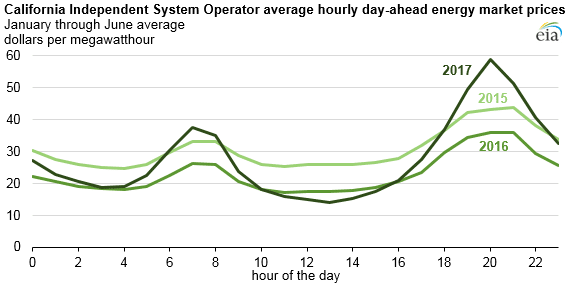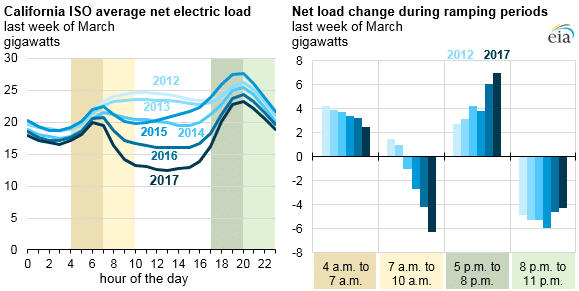By most metrics, California leads the United States in the deployment of solar PV. In 2016 solar represented 13% of the state’s electricity generation, and in the first quarter of the year solar and other renewable sources provided more than 50% of in-state generation.
This is having impacts across the state’s power sector, and as the latest the U.S. Department of Energy’s Electricity Information Administration (EIA) has documented how abundant solar resources are driving a need for more flexible generation to meet demand when solar is not available, which is reflected in increased wholesale electricity prices during the evening peak.
According to an analysis by EIA, from January through June 2017 day-ahead electricity prices increased to nearly $60 per megawatt-hour (MWh) at 8 PM, while falling to below $15 per megawatt-hour during the middle of the day. This is a marked increase from the first six months of 2016, when day-ahead prices at 8 PM were only around $35 per MWh.

The EIA analysis also shows increased electricity prices from 6 to 8 AM, but these are much lower than the evening prices. And it is important to note that on a 24-hour basis, solar and wind are generally helping to drive down wholesale electricity prices.
The problem of the “duck curve”, as this phenomenon is know, is most pronounced during the spring, when solar generation is increasing but temperatures are not high enough to spur the use of air conditioning. As such, during spring evenings the ramp required by generators is increasing, with nan average of early 7 GW of ramp needed during the last week of March this year.

This is good news for generators that can ramp quickly, such as fast-ramping gas plants and battery storage systems. It is bad news for inflexible plants, such as the state’s Diablo Canyon nuclear plant, which is scheduled to go offline in 2026.
Unfortunately, a bill to provide stable incentives for behind-the-meter energy storage died in a committee of the California Assembly earlier this month.
But batteries and gas plants are not the only means that are being deployed in the state to deal with the changing dynamics of electricity supply and demand. Last week the San Diego Water Authority issued an RFP for a pumped hydroelectric storage facility which will be able to provide five to eight hours of storage, which will assist with renewable energy integration.
Unlike the smaller battery systems which are being deployed, the San Diego pumped hydro plant will have a capacity of up to 500 MW. Additionally, California’s grid operator is expanding its Energy Imbalance Market, a regional network that will allow for more rapid trading of electricity with neighboring grids.
This content is protected by copyright and may not be reused. If you want to cooperate with us and would like to reuse some of our content, please contact: editors@pv-magazine.com.








Duck pancake
The Duck Curve is a 2012 hypothesis about consumption (not electricity price, though obviously these are linked by market) related to the penetration of solar including rooftop that is not playing out as predicted.
Obviously solar erodes the day time market, but when the duck curve hypothesis was created, it assumed overall energy consumption would increase, and so bring pressure on the evening market as the sun went down, producing the elongated duck neck. Energy consumption across the OECD has been falling since the mid 2000s, but this trend was not properly recognised until about 2012, and was not recognised in the duck curve hypothesis when it was erected.
But evening demand is down not up — as the graphs above clearly show. The duck curve is not happening as predicted as the assumption of consumption was flawed. https://twitter.com/ProfRayWills/status/893648819685949441
The data has not supported the hypothesis, so stop treating it as a theorem.
It is critical to recognise this as the duck curve is still being cited and influencing, but not properly informing, policy discussion.